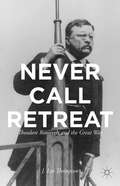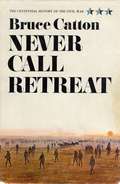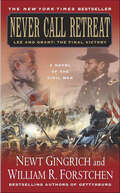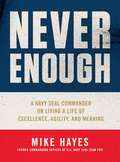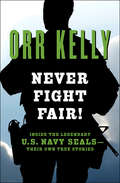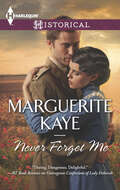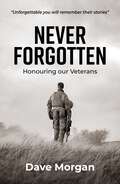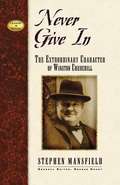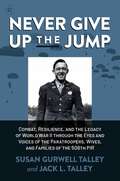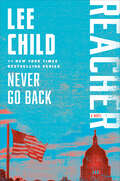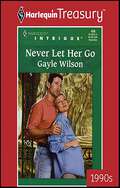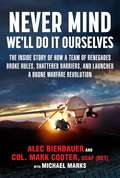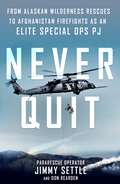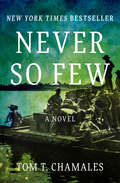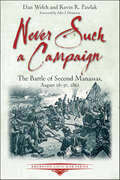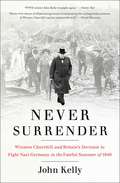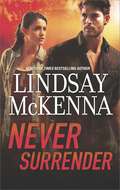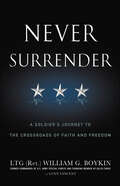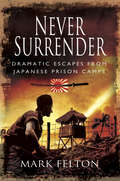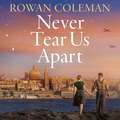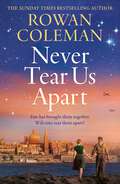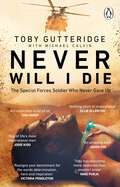- Table View
- List View
Never Call Retreat
by J. Lee ThompsonThe first modern account of Theodore Roosevelt and the First World War, this is a tale of war and politics as well as the private story of true love and family devotion: a story as multi-faceted as TR's own personality.
Never Call Retreat (The American Civil War Trilogy #3)
by Bruce Catton"A magnificent stylist . . . a first-rate historian. Familiarity with subject matter resulting from many years of study and narrative talents exceeding those of any other Civil War historian enable him to move along swiftly and smoothly and produce a story that is informative, dramatic, and absorbingly interesting." —Dr. Bell I. Wiley, after reading the manuscript of Never Call Retreat The final volume of Bruce Catton's monumental Centennial History of the Civil War traces the war from Fredericksburg through the succeeding grim and relentless campaigns to the Courthouse at Appomattox and the death of Lincoln. This is an eloquent study of the bitterest years of the war when death slashed the country with a brutality unparalleled in the history of the United States. Through the kaleidoscope tone and temper of the struggle, two men, different in stature, but similar in dedication to their awesome tasks, grappled with the burden of being leaders both in politics and war. In the north Lincoln remained resolute in the belief that a house divided against itself could not stand. His determination and uncanny vision of the destiny of the country and its people far transcended the plaguing tensions, fears, and frustrations of his cabinet and Congress. Mr. Lincoln’s use of vast resources is brilliantly contrasted to Davis’s valiant struggle for political and economic stability in a hopelessly fragmented and underdeveloped south. Though Davis never lacked for spirit and dedication, his handicaps were severe. This was not a war to be won by static ideals and romanticism. As Mr. Lincoln managed to expand and intensify the ideals that sustained the Northern war effort, Mr. Davis was never able to enlarge the South’s. This was a war to be won by flexibility in though, strength in supplies, and battles. And so they were fought––Fredericksburg, The Wilderness, Chancellorsville, Vicksburg, Gettysburg.
Never Call Retreat: Lee and Grant: The Final Victory, A Novel of the Civil War (The Gettysburg Trilogy #3)
by Newt Gingrich William R. ForstchenThe New York Times–bestselling alternative history of the Civil War reaches its thrilling climax in this “swiftly paced and authentically grounded novel” (Booklist).After his great victories at Gettysburg and Union Mills, General Robert E. Lee fails to attain final victory with his attack on Washington, D.C. But even as Union General Dan Sickles secures Washington, he and his valiant Army of the Potomac are trapped and destroyed. For Lincoln there is only one hope left: that General Ulysses S. Grant can save the Union cause.It is now August 22, 1863. Lee must conserve his remaining strength while maneuvering for the killing blow that will take Grant’s army out of the fight. Pursuing the remnants of the defeated Army of the Potomac up to the banks of the Susquehanna, Lee is caught off balance when news arrives that General Ulysses S. Grant, in command of more than seventy thousand men, has crossed that same river, a hundred miles to the northwest at Harrisburg.As General Grant brings his Army of the Susquehanna into Maryland, Robert E. Lee’s Army of Northern Virginia maneuvers for position. Grant first sends General George Armstrong Custer on a mad dash to block Lee’s path toward Frederick and with it control of the crucial B&O railroad. The two armies finally collide in Central Maryland, and a bloody week-long battle ensues along the banks of Monocacy Creek. This must be the “final” battle for both sides.
Never Enough: A Navy SEAL Commander on Living a Life of Excellence, Agility, and Meaning
by Mike HayesIn Never Enough, Mike Hayes—former Commander of SEAL Team TWO—helps readers apply high-stakes lessons about excellence, agility, and meaning across their personal and professional lives.Mike Hayes has lived a lifetime of once-in-a-lifetime experiences. He has been held at gunpoint and threatened with execution. He’s jumped out of a building rigged to explode, helped amputate a teammate’s leg, and made countless split-second life-and-death decisions. He’s written countless emails to his family, telling them how much he loves them, just in case those were the last words of his they’d ever read. Outside of the SEALs, he’s run meetings in the White House Situation Room, negotiated international arms treaties, and developed high-impact corporate strategies.Over his many years of leadership, he has always strived to be better, to contribute more, and to put others first. That’s what makes him an effective leader, and it’s the quality that he’s identified in all of the great leaders he’s encountered. That continual striving to lift those around him has filled Mike’s life with meaning and purpose, has made him secure in the knowledge that he brings his best to everything he does, and has made him someone others can rely on.In Never Enough, Mike Hayes recounts dramatic stories and offers battle- and boardroom-tested advice that will motivate readers to do work of value, live lives of purpose, and stretch themselves to reach their highest potential.
Never Fight Fair!: Inside the Legendary U.S. Navy SEALs—Their Own True Stories
by Orr KellyA riveting oral history of the US Navy SEALs—from World War II to Vietnam to Iraq—in the words of the warriors themselves&“It is better to die than to look bad or lose.&” —Capt. Ronald YeawThere is no more elite fighting force in the world than the esteemed US Navy SEALs. Famous for their rigorous training, fearlessness, and incomparable skills on sea, air, and land, these are the warriors who are routinely charged with carrying out the most dangerous combat assignments, always in secret and under cover of darkness. Much has been written about their remarkable achievements, from the earliest days of the World War II Underwater Demolition Teams through action in the Persian Gulf. But now these courageous men get to speak for themselves, telling their riveting war stories in their own words.Veteran military author Orr Kelly (Brave Men, Dark Water) has gathered together the stunning recollections of current and former SEALs to present a vivid and breathtaking picture of life and death among the best of the best in US Military Special Operations. These brave men speak openly about their training and their missions, offering the uncensored, inspiring, sometimes shocking truth about their combat triumphs and the rare but devastating failures. They carry the reader along with them on the path to glory and into the blistering heat of the fires of war.
Never Forget Me
by Marguerite KayeAS WAR BLAZES ACROSS EUROPE, THREE COUPLES FIND A LOVE THAT IS POWERFUL ENOUGH TO OVERCOME ALL THE ODDS... A KISS GOODBYE 1914 As war looms, genteel Flora yearns to be more than just an observer. She finds a revolutionary kindred spirit in soldier Geraint-but will their fragile love be crushed before it can start to bloom? DEAREST SYLVIE 1916 Soldier Robbie cannot forget his one hedonistic night in Paris with beautiful waitress Sylvie. But as Europe burns, can these two star-crossed lovers ever be reunited? FOREVER WITH ME 1918 Nurse Sheila is horrified to discover her new boss is the French surgeon she woke beside after Armistice Day! Fighting for their love will be the bravest thing she's ever had to do....
Never Forgotten: Honouring our Veterans
by Dave MorganIn the shadows of war, their voices resonate: Australian veterans' tales: Untold stories of Australia&’s forgotten soldiers. Vietnam Veteran Dave Morgan explores the often-overlooked sacrifices of Australian military personnel. Inspired by his own experiences, Dave embarks on a journey to capture the diverse narrative spanning generations and conflicts, from Vietnam to Somalia and Afghanistan. Through meticulous research and armchair conversations, he uncovers untold stories, from talented athletes like Ian Anderson to pioneering female veterans like Stephanie Shipman. The book weaves together tales of camaraderie and resilience, from heartwarming reunions to the loss of friends like Robert Wilson. These accounts offer a mosaic of bravery and resilience and through these stories, readers gain a deeper understanding of the profound impact of military service on individuals and communities, highlighting the importance of preserving these invaluable narratives. Never Forgotten serves as a poignant reminder of the sacrifices made by those who serve, ensuring their voices resonate for future generations. All proceeds from this book will be donated to Legacy Australia.
Never Give In: The Extraordinary Character of Winston Churchill
by Stephen MansfieldWinston Churchill was one of the most extraordinary leaders of the twentieth century. What was it that enabled him to stand so steadfastly when all those around him seemed to turn back in fear? What was it that enabled him to inspire whole nations to endure the unendurable and to achieve the unachievable when all those around him had already surrendered all hope? This remarkable new study of Churchill's leadership skill answers these questions and more. The result is an account that is as inspiring today as it was more than half a century ago when the great man' shadow fell large across the world stage. According to Henry Kissinger, Our age finds it difficult to come to grips with Churchill. The political leaders with whom we are familiar generally aspire to be superstars rather than heroes. The distinction is crucial. Superstars strive for approbation; heroes walk alone. Superstars crave consensus; heroes define themselves by the. . . future they see it as their risk to bring about. Superstars seek success in a technique for eliciting support; heroes pursue success as the outgrowth of their inner values. Winston Churchill was a hero.
Never Give Up the Jump: Combat, Resilience, and the Legacy of World War II through the Eyes and Voices of the Paratroopers, Wives, and Families of the 508th PIR
by Susan Gurwell Talley Jack L. TalleyThe daughter of a D-Day paratrooper and her husband, a PTSD therapist, discover a family legacy of love, trauma, and resilience when they set out to explore a vast trove of WWII correspondence, official military documents, personal effects, and unique militaria found in closets and basements after her father&’s death.Young Sue Gurwell had always known that her father had been a paratrooper. An old camo parachute from Holland served as her backyard tent, and high on a shelf she mustn&’t touch, eight red devils in parachutes grinned from the front of mysterious drinking glasses Dad had sent Mom during the war. And then there was the special poem in his roll-top desk she sometimes snuck a peek at, written by a member of Dad&’s regiment. This poem was a premonition of the sergeant&’s death. &“Yes,&” her dad told her, &“He was right—he died on D-Day.&” But it&’s not until 2016, after her parents had both passed away, that Susan Gurwell Talley and her husband Jack L. Talley begin to understand the true extent and significance of the wartime artifacts that had been staples of Sue&’s childhood. The Talley&’s discovered that Sue&’s father, Lt. George L. Gurwell, Executive Officer, HqHq, 508th PIR, had silently squirreled away thousands of wartime documents in the family home. Like most combat veterans, George was never one to talk about the war; but the historic collection of official records, correspondence, photographs, maps, memorabilia, cultural artifacts, and unique ephemera constitute quite possibly the most extensive, various, and complete documentation of the 508th held privately today. This precious resource could not have passed into better hands than those of Jack and Sue Talley. Jack, a PhD psychologist specializing in PTSD, was the first to understand that George had PTSD symptoms that still lingered from the war years when he and George were introduced on June 6, 2001. That evening, the 57th anniversary of D-Day, George first opened up about the war, and preceded to talk late into the night. In that conversation lies the genesis of this book.
Never Go Back: A Jack Reacher Novel (Jack Reacher #18)
by Lee Child#1 NEW YORK TIMES BESTSELLER • Never go back—but Jack Reacher does, and the past finally catches up with him. . . . Never Go Back is a novel of action-charged suspense starring &“one of the best thriller characters at work today&” (Newsweek). Don&’t miss the hit streaming series Reacher!Former military cop Jack Reacher makes it all the way from snowbound South Dakota to his destination in northeastern Virginia, near Washington, D.C.: the headquarters of his old unit, the 110th MP. The old stone building is the closest thing to a home he ever had.Reacher is there to meet—in person—the new commanding officer, Major Susan Turner, so far just a warm, intriguing voice on the phone.But it isn&’t Turner behind the CO&’s desk. And Reacher is hit with two pieces of shocking news, one with serious criminal consequences, and one too personal to even think about.When threatened, you can run or fight.Reacher fights, aiming to find Turner and clear his name, barely a step ahead of the army, and the FBI, and the D.C. Metro police, and four unidentified thugs.Combining an intricate puzzle of a plot and an exciting chase for truth and justice, Lee Child puts Reacher through his paces—and makes him question who he is, what he&’s done, and the very future of his untethered life on the open road.Don&’t miss Lee Child&’s short story &“High Heat&” in the back of the book.
Never Let Go (A Blue Ridge Romance #3)
by Allison B. HansonJust one gorgeous weekend away from reality. Then they can go on like it never happened...Riley Fisher doesn't have time to chase after men. As a single mother working two jobs, she barely has time to eat or sleep. But a girl has needs. So when handsome veteran Sam Brooks asks her out, she decides she deserves some R&R. She doesn't expect anything else from him--after all, he's hardly the type to get serious.Sam came back from Afghanistan lucky to be alive, despite PTSD that hits whenever he lets down his guard. His therapist told him to forget about relationships. When he meets Riley, he's not planning on breaking the rules. She's cute, petite, and a total smartass--not even his type. But she's hard to forget. Especially once he runs into Riley and her toddler on a rustic mountain getaway and sees what he's missing. Her kid makes him laugh all day. And Riley makes him burn all night.Too bad a relationship is impossible. But they can enjoy the attraction. It's not like they're going to fall in love...
Never Let Her Go
by Gayle WilsonHe'd forgotten so muchUndercover agent Nick Deandro lost more than his vision when a shotgun blast shattered his life. Only he and the woman he loved knew the promises they'd just made: rings, babies, mortgages. Now he'd forgotten them all. Her name, her face...all but her touch.And he'd never known about the childAbby Sterling needed a rest. They promised her watching Nick would be just that-a safe job. But not for Abby. Because how could she protect Nick, stand close, when between them lay all that he'd forgotten? Every kiss. Every promise...and her growing secret.
Never Let The Meat Touch The Metal
by Robert CooperWhat makes a hero? Is it an individual who does things above and beyond the call of duty or is it someone who just keeps sticking his big fat nose into all the wrong places at the wrong time. Max is a young man in Poland who finds himself conscripted into the military prior to World War Two. His ability to speak a number of foreign languages and cook bring him to the attention of the High Command. A number of this elite group take a liking to him and he winds up learning things that most soldiers cannot even phantom, amongst them is the skills of a spy. When the war breaks out, Max uses these skills against the Germans; but in his travels, he discovers that they are not his only adversaries. Max begins to ask questions that no one wants to answer. In his quest to find these answers, he uncovers the true secrets of the war. The question then becomes who he can trust. Especially when it seems like everyone is trying to kill him to keep there dirty little secrets.
Never Mind, We'll Do It Ourselves: The Inside Story of How a Team of Renegades Broke Rules, Shattered Barriers, and Launched a Drone Warfare Revolution
by Bierbauer Alec Col. Mark Cooter Michael E. Marks&“An extraordinary, riveting, page-turning account—finally cleared for publication by the CIA—of the once highly classified effort by the CIA and special military units to develop a truly game-changing, transformational capability: armed drones."—General David Petraeus, US Army (Ret.), former Commander of the Surge in Iraq, US Central Command, and US and Coalition Forces in Afghanistan, and former Director of the CIAThe Inside Story of How a CIA Officer and an Air Force Officer Joined Forces to Develop America&’s Most Powerful Tool in the War on Terror. Never Mind, We&’ll Do It Ourselves is the story behind the origins of the Predator drone program and the dawn of unmanned warfare. A firsthand account told by an Air Force team leader and a CIA team leader, Never Mind, We&’ll Do It Ourselves takes readers into the back offices and secret government hangars where the robotic revolution went from a mad scientist idea to a pivotal part of global airpower. Featuring a foreword by Charlie Allen, an introduction by Lieutenant General John Campbell, USAF (Ret.), and an afterword by Lieutenant Colonel Gabe Brown, the story reveals the often conflicting perspectives between the defense and intelligence communities and puts the reader inside places like the CIA&’s counterterrorism center on the morning of 9/11. Through the eyes of the men and women who lived it, you will experience the hunt for Usama bin Laden and the evolution of a program from passive surveillance to the complex hunter-killers that hang above the battlespace like ghosts.Poised at the junction between The Right Stuff and The Bourne Identity, Never Mind, We&’ll Do It Ourselves documents the way a group of cowboys, rogues, and bandits broke rules and defied convention to change the shape of modern warfare
Never Quit: From Alaskan Wilderness Rescues To Afghanistan Firefights As An Elite Special Ops Pj
by Don Rearden Jimmy Settle“That Others May Live” is a mantra that defines the fearless men of Alaska’s 212th Pararescue Unit, the PJs, one of the most elite military forces on the planet. Whether they are rescuing citizens injured and freezing in the Alaskan wilderness or saving wounded Rangers and SEALS in blazing firefights at war, the PJs are the least known and most highly trained of America’s warriors. Never Quit is the true story of how Jimmy Settle, an Alaskan shoe store clerk, became a Special Forces Operator and war hero. After being shot in the head during a dangerous high mountain operation in the rugged Watapur Valley in Afghanistan, Jimmy returns to battle with his teammates for a heroic rescue, the bullet fragments stitched over and still in his skull. In a cross between a suicide rescue mission and an against-all-odds mountain battle, his team of PJs risk their lives again in an epic firefight. When his helicopter is hit and begins leaking fuel, Jimmy finds himself in the worst possible position as a rescue specialist—forced to leave members from his own team behind. Jimmy will have to risk everything to get back into the battle and bring back his brothers.From death-defying Alaskan wilderness training, wild rescues, and vicious battles against the Taliban and Al Qaeda, this is an explosive special operations memoir unlike any that has come before, and the true story of a man from humble beginnings who became an American hero.
Never Say Die (Destroyer, #110)
by Mike NewtonWhen the figer prints of two dead hitman match perfectly those of a man who was juditiously exicuted in the 1930's, Dr. Howard Smith decides that it takes a dead man to fidn a dead man. Now Remo and Chiun must search for the truth of about these myserious dopplgangers.
Never So Few: A Novel
by Tom T. ChamalesSet behind enemy lines in Burma, this New York Times bestseller is &“easily one of the best novels to come out of World War II&” (Los Angeles Times). American soldiers and native Kachin troops battle Japanese forces behind enemy lines in the Burmese jungles. But during the brutal campaign to gain territory in the unforgiving tropical landscape, Captain Reynolds and his band of special operations soldiers and guerrilla fighters struggle to find self-awareness, and even love, in the midst of the trials of combat. One of the youngest officers to serve in Merrill&’s Marauders and OSS Detachment 101—precursors to the Green Berets and Central Intelligence Agency—author Tom T. Chamales brings an unparalleled level of authentic detail and raw intensity to this work of fiction based on his real-life experience in the jungles of Southeast Asia. Never So Few is &“an extraordinary and powerful book,&” unflinching in its portrayal of wartime sacrifice and violence (Kirkus Reviews, starred). The basis for the movie starring Frank Sinatra and Steve McQueen, it offers &“dramatic, exciting, and concretely detailed accounts of battle action,&” and joins the ranks of other classic war novels such as From Here to Eternity and The Naked and the Dead in bringing later generations to the frontlines and into the inner lives of the brave men who served (The New York Times).
Never Such a Campaign: The Battle of Second Manassas, August 28–August 30, 1862 (Emerging Civil War Series)
by Dan Welch Kevin R. PawlakHistorians Robert Orrison and Dan Welch follow Lee and Pope as they converge on ground once-bloodied just thirteen months earlier. In late June 1862, Gen. Robert E. Lee’s Army of Northern Virginia drove back Maj. Gen. George McClellan’s Army of the Potomac from the gates of the Confederate capital. Richmond was safe—at least for the moment. Another threat soon emerged when the Army of Virginia, a new command under Maj. Gen. John Pope, moved toward Fredericksburg, threatening Confederate communications, supply points, and Richmond. Pope, who had a reputation as something of a braggart, had scored victories along the Mississippi River at New Madrid and Island No. 10. President Lincoln was hopeful he would replicate that success in Virginia. Pope brought with him a harder philosophy of war, one that would put pressure not just on Lee’s army but on the population of Virginia. Alarmed and offended by “such a miscreant as Pope,” Lee began moving part of his army north to counter and “suppress” the threat. In Never Such a Campaign: The Battle of Second Manassas, August 28–30, 1862, historians Dan Welch and Kevin R. Pawlak follow Lee and Pope as they converge on ground bloodied just thirteen months earlier at First Bull Run (Manassas). Since then, the armies had grown in both size and efficiency, and any pitched combat between them promised to dwarf the earlier battle. For the second summer in a row, Union and Confederate forces clashed on the plains of Manassas. This time, the results would be far more terrible.
Never Surrender
by John KellyA remarkably vivid account of a key moment in Western history: The critical six months in 1940 when Winston Churchill debated whether the British would fight Hitler.London in April, 1940, was a place of great fear and conflict. Everyone was on edge; civilization itself seemed imperiled. The Germans are marching. They have taken Poland, France, Holland, Belgium, and Czechoslovakia. They now menace Britain. Should Britain negotiate with Germany? The members of the War Cabinet bicker, yell, lose their control, and are divided. Churchill, leading the faction to fight, and Lord Halifax, cautioning that prudence is the way to survive, attempt to usurp one another by any means possible. Their country is on the line. And, in Never Surrender, we feel we are alongside these complex and imperfect men, determining the fate of the British Empire. Drawing on the War Cabinet papers, other government documents, private diaries, newspaper accounts, and memoirs, historian John Kelly tells the story of the summer of 1940--the months of the "Supreme Question" of whether or not the British were to surrender. Impressive in scope and attentive to detail, Kelly takes readers from the battlefield to Parliament, to the government ministries, to the British high command, to the desperate Anglo-French conference in Paris and London, to the American embassy in London, and to life with the ordinary Britons. He brings to life one of the most heroic moments of the twentieth century and intimately portrays some of its largest players--Churchill, Lord Halifax, FDR, Joe Kennedy, Hitler, Stalin, and others. Never Surrender is a fabulous, grand narrative of a crucial period in World War II history and the men and women who shaped it.
Never Surrender (Shadow Warriors)
by Lindsay McKenna&“McKenna takes readers on a gritty and emotional journey with this high-octane sequel to Breaking Point . . . will move readers to tears.&” —Publishers Weekly (starred review) Despite her sweet nature, Navy medic Bay Thorn&’s will is unbreakable. It has earned her not only the respect of her team, but also the love of Navy SEAL Gabe Griffin. And as soon as she wraps up the final six months of Operation Shadow Warriors in Afghanistan, she&’ll have her happily ever after . . . Until her deployment goes horribly wrong. Bay&’s medical expertise is needed by the Taliban, and she is taken hostage. Her captor is ruthless and cruel, and Bay isn&’t exempt from his evil intents. All that&’s left now is her resolve and the too-distant memory of Gabe—her last and only hope for rescue. And to pull Bay from hell, this SEAL will have to break every rule in the book. But will Gabe find the woman he loves . . . or a woman broken beyond recognition? &“[A] dynamic black-ops thriller . . . Ms. McKenna masterfully blends the two different paces to convey a beautiful saga about love, trust, patience and having faith in each other.&” —Fresh Fiction &“McKenna&’s expert knowledge of the Navy SEALs gives authenticity to a very tender and heartwrenching story. Filled with non-stop action, Never Surrender grabs at the heart.&” —RT Book Reviews &“[A] truly memorable story . . . this one has a special, heartbreaking resonance.&” —Booklist
Never Surrender: A Soldier's Journey to the Crossroads of Faith and Freedom
by Lynn Vincent Jerry BoykinIn 1978, Jerry Boykin joined what would become the world's premier Special Operations unit, Delta Force. The only promise: "A medal and a body bag." What followed was a .50 caliber round in the chest and a life spent with America's elite forces bringing down warlords and war criminals, despots, and dictators. In Colombia, his task force hunted the notorious drug lord Pablo Escobar. In Panama, he helped capture the brutal dictator Manuel Noriega, liberating a nation. From Vietnam to Iran to Mogadishu, Lt. General Jerry Boykin's life reads like an action-adventure novel. Boykin's powerful story will keep you riveted as he reveals how his military duty worked in tandem with his faith to bring him through the bloody storms of foreign battle-and through the political firestorm that ambushed him in his own country.
Never Surrender: Dramatic Escapes from Japanese Prison Camps
by Mark FeltonWhile there have been many fine books covering the appalling experiences and great courage of the many thousands of POWscaptured by the victorious Japanese during late 1941 and early 1942, escape accounts are much rarer. This is due in large part tothe fact that only a comparatively small number of brave souls attempted to escape to freedom rather than suffer brutality,starvation and very possibly death as POWs. However, as Never Surrender vividly describes, there were a significant number who took this desperate course. Escapersfaced challenges far more daunting than those in German hands. They were Westerners in an alien, hostile environment; the terrain and climate were extreme; disease was rife; their physical condition was weak; there was every chance of starvation andbetrayal and, if captured, they faced, at best, the harshest punishment and, at worst, execution. The author draws on escapeattempts from Hong Kong, Thailand, the Philippines, Borneo and China by officers and men of the British, Commonwealth andUS armed forces. As this superbly researched and uplifting book reveals, few escapers found freedom but all are inspiring examples of outstandingand, indeed, desperate courage. The stories told within these pages demonstrate the best and worst of human spirit.
Never Tear Us Apart: a spellbinding, sweeping historical story about love, war and fate, new for 2025 from the bestselling author
by Rowan ColemanA spellbinding tale of love, strength and sacrifice from the Sunday Times bestselling author. Based on the gorgeous island of Malta in WWII, this is a story about the power of fate, and how sometimes, in order to find yourself - and to find love - you must first lose everything else. . .Fate has brought them together. Will time tear them apart?2025Named after a star, war correspondent Maia knows how to find the brightest stories - the tales of survival and strength - hidden amongst the dark realities of combat.Now, travelling to Malta to visit her estranged father, with one more chance to build a relationship with her last remaining relative, she's here to find her own story: never having found somewhere - or someone - she can call home, she's desperate for answers that might show her where she truly belongs.But when she arrives on the beautiful mediterranean island, she realises her long-lost family is full of more secrets than she could possibly have imagined. . .1942Maia wakes up to find herself on an island under siege, a city in ruins - and knows she must have been sent here for a reason.Who has she been sent to save? Or is it Maia herself that needs saving? And just when she's finally found what she's been seeking . . . will time separate them forever? Perfect for fans of Lucinda Riley, Santa Montefiore and Dinah Jefferies.YOUR FAVOURITE AUTHORS LOVE ROWAN COLEMAN:'An incredible story of love and hope' KATIE FFORDE'It's so lovely to find an author you love' MARIAN KEYES'Such a brilliant writer' JILL MANSELL'I've always loved Rowan's writing' LUCY DILLON'There is a lovely smooth glow to the writing' MATT HAIG'Life-affirming and joyful' SARA SHERIDAN'A time-travelling delight' EVE CHASE'Gloriously romantic and deeply moving' LUCY DIAMOND'A stunning book about what it takes to be truly alive' JULIE COHEN'Wonderful . . . both emotional and utterly captivating' JILL MANSELL'A book you will carry with you long after the last page' MILLY JOHNSON'Up there alongside The Time Traveller's Wife' CAROLE MATTHEWS'Captivating and completely unforgettable, Vita and Ben's love story made me believe the impossible might not be so far out of reach' JULIETTA HENDERSON
Never Tear Us Apart: a spellbinding, sweeping historical story about love, war and fate, new for 2025 from the bestselling author
by Rowan ColemanA spellbinding tale of love, strength and sacrifice from the Sunday Times bestselling author. Based on the gorgeous island of Malta in WWII, this is a story about the power of fate, and how sometimes, in order to find yourself - and to find love - you must first lose everything else. . .Fate has brought them together. Will time tear them apart?2025Named after a star, war correspondent Maia knows how to find the brightest stories - the tales of survival and strength - hidden amongst the dark realities of combat.Now, travelling to Malta to visit her estranged father, with one more chance to build a relationship with her last remaining relative, she's here to find her own story: never having found somewhere - or someone - she can call home, she's desperate for answers that might show her where she truly belongs.But when she arrives on the beautiful mediterranean island, she realises her long-lost family is full of more secrets than she could possibly have imagined. . .1942Maia wakes up to find herself on an island under siege, a city in ruins - and knows she must have been sent here for a reason.Who has she been sent to save? Or is it Maia herself that needs saving? And just when she's finally found what she's been seeking . . . will time separate them forever?Perfect for fans of Lucinda Riley, Santa Montefiore and Dinah Jefferies.YOUR FAVOURITE AUTHORS LOVE ROWAN COLEMAN:'An incredible story of love and hope' KATIE FFORDE'It's so lovely to find an author you love' MARIAN KEYES'Such a brilliant writer' JILL MANSELL'I've always loved Rowan's writing' LUCY DILLON'There is a lovely smooth glow to the writing' MATT HAIG'Life-affirming and joyful' SARA SHERIDAN'A time-travelling delight' EVE CHASE'Gloriously romantic and deeply moving' LUCY DIAMOND'A stunning book about what it takes to be truly alive' JULIE COHEN'Wonderful . . . both emotional and utterly captivating' JILL MANSELL'A book you will carry with you long after the last page' MILLY JOHNSON'Up there alongside The Time Traveller's Wife' CAROLE MATTHEWS'Captivating and completely unforgettable, Vita and Ben's love story made me believe the impossible might not be so far out of reach' JULIETTA HENDERSON
Never Will I Die: The inspiring Special Forces soldier who cheated death and learned to live again
by Michael Calvin Toby GutteridgeThere's no pain, no theatrical agony. No screaming, no shouting. The kill shot is catastrophic and conclusive. I slump silently on to my knees and topple forward, head first, into the dirt. The lads have seen enough death to assume mine is instantaneous. The lights are out. That's him gone.Toby Gutteridge was only 24 when he was shot through the neck while operating behind enemy lines in Afghanistan. He survived despite not breathing for at least 20 minutes. Back in the UK, doctors recommended that his life support machine be switched off, but with the defiant spirit that would define his recovery, Toby pulled through.Now quadriplegic, capable of movement only with his head, Toby has rebuilt his life. His is an extraordinary story of survival against overwhelming odds, and of the power of the human spirit to overcome extreme adversity. Brutally honest and authentic, he builds a compelling picture of the type of person produced by the Special Forces system, and tells of how one split second changed the course of his life forever.Powerful and inspiring, Never Will I Die is a universal story about our search for purpose, and explores what extreme experience teaches us about what truly matters.
